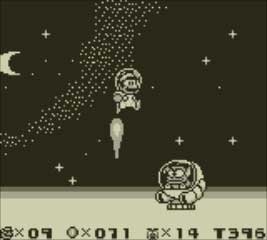
I have a confession to make: while it’s true I didn’t own a Game Boy until the release of Pokémon Yellow, some seven years after Super Mario Land 2 debuted, I did actually get to play the game before it appeared on the eShop, through some more– ahem– dubious channels. I couldn’t help it; I was young, and my moral compass had not yet fully developed. The prospect of playing any game free of charge via an emulator, which I had learned about through the seedy underworld of the sixth grade classroom, was far too tempting for a kid to resist.
Given my history with the game, then, I already knew what to expect when I downloaded Super Mario Land 2 on my 3DS. I had never finished it back when I played it on my emulator– keyboards don’t exactly lend themselves well to platformers– but I’d seen enough of the game to get a general feel for its design, which seemed to hew pretty closely to the standard Mario gameplay.
What strikes me most about Super Mario Land 2 now that I’ve played it all the way through is just how well it holds up to the plumber’s console adventures. The first Super Mario Land, fun as it was, came off as a simplified version of the original Super Mario Bros., with fewer levels and even more basic visuals than the NES title. (It was also pretty weird, what with its exploding Koopas and its errant moai statues, but that’s beside the point.) Super Mario Land 2 retained some of its predecessor’s quirks, but it was much more ambitious in every regard: its visuals were far more detailed, mimicking the aesthetic style of Super Mario World about as accurately as possible on the Game Boy’s limited technology; its mechanics were much tighter, giving gamers a greater degree of control over Mario; and its gameplay was more sophisticated, with a greater variety of levels to explore and new power-ups with which to conquer them.
If there’s a white space here, please refresh your browser!
Not only did Super Mario Land 2 feel more like a console Mario game than its predecessor, it introduced its own share of innovations to the series as well, many of which would remain exclusive to this adventure (or would be expanded on in the Wario Land games that splintered off from it). Prior Marios had a world map, sure, but none gave you the freedom to explore it in any order you chose like you could here. This had a profound impact on the game design, as it meant each zone had to be scaled, difficulty-wise, to accommodate new players, as it was impossible to predict which one they’d start with first. It also gave Super Mario Land 2 a distinct sandbox-like feel, a design choice that would be more fully realized in the revolutionary Super Mario 64 a couple of years later.
What’s more, the game featured some of the most original locales the plumber has ever explored. It’s easy to see why the New Super Mario series is often criticized for being bland when you compare it to his earlier adventures. Each game from Mario’s heyday featured its own distinctive set of environments: Super Mario 3 canonized the grass, desert, ice, and water worlds that would become the staple of the New Super Mario titles, while Super Mario World’s caverns and plains lent Dinosaur Land—the game’s setting– an appropriately prehistoric feel. Super Mario Land 2 shared some level motifs with its predecessors (what Mario game doesn’t begin in a grassland?), but it introduced a host of unique ones to the series as well, like the low-gravity Space Zone (which would mark the first time the plumber has ever explored the cosmos), or the Halloween-inspired Pumpkin Zone.


Perhaps most importantly, Super Mario Land 2 tasks Mario with something other than rescuing Princess Peach. This isn’t all that unprecedented for the series; the first Super Mario Land likewise made no mention of her or her perpetual captor, Bowser, though it did introduce a hapless substitute in Princess Daisy. But what makes this case particularly noteworthy is that it eschews this trope completely, making it truly unique among Mario’s side-scrolling adventures. Here Mario must reclaim his castle from the debuting Wario, who seized it while the plumber was off exploring Sarasaland in the previous title. To do so, he must travel about the world collecting the six eponymous golden coins, which are scattered about the land and under the protection of each zone’s boss character. This may not seem all that different from previous Mario storylines, but its implications are clearly felt in the game’s structure, which makes it the most radical of its innovations.
It’s a shame, then, that Super Mario Land 2 doesn’t get the same recognition as Super Mario 3 or Super Mario World, as it holds up remarkably well to the plumber’s more famous adventures. It’s true the game is a good deal shorter than either of those two title (indeed, the word “land” implies it will be a smaller affair than something like Super Mario World), but that is more a symptom of its platform than a flaw in its design. In any case, the game more than compensates for its length with its imaginative levels and its free-form structure, and any Mario fans who have yet to play Super Mario Land 2 definitely owe it to themselves to check it out. It might not have the same legacy as his console titles, but it’s still one of Mario’s best outings.




 ShareThis
ShareThis







This was the first video game I played when my neighbor brought over a bag of old toys which included a original game boy in its leather pouch and had other rare gems like Kirby Pinball and Super Mario Land 3. This game started my love for nintendo.